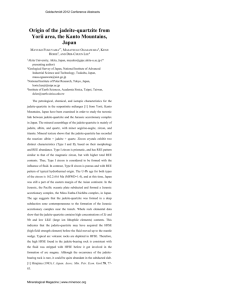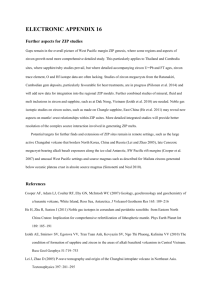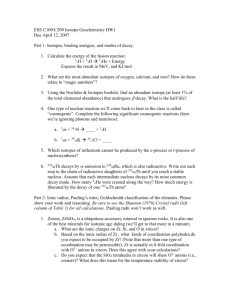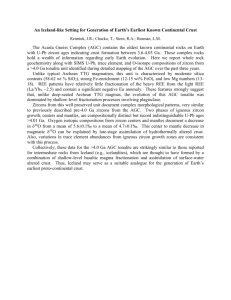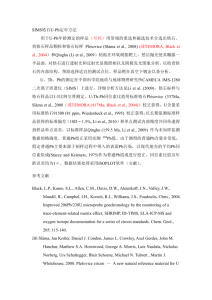PageOne - SHRIMP - Australian National University
advertisement
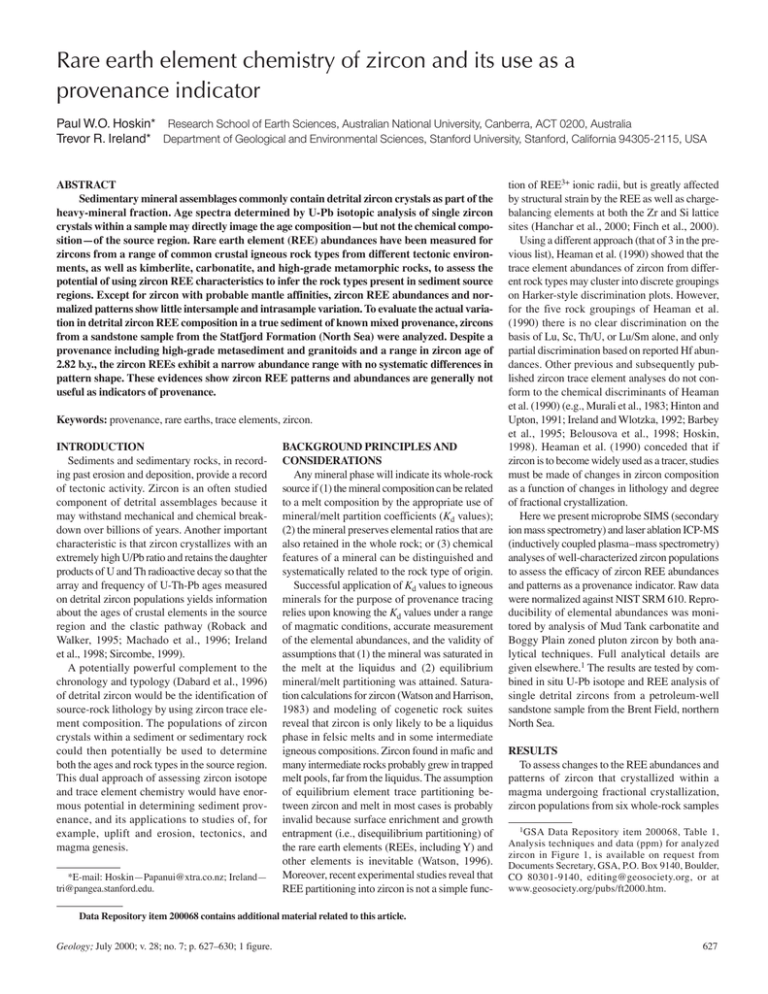
Rare earth element chemistry of zircon and its use as a provenance indicator Paul W.O. Hoskin* Research School of Earth Sciences, Australian National University, Canberra, ACT 0200, Australia Trevor R. Ireland* Department of Geological and Environmental Sciences, Stanford University, Stanford, California 94305-2115, USA ABSTRACT Sedimentary mineral assemblages commonly contain detrital zircon crystals as part of the heavy-mineral fraction. Age spectra determined by U-Pb isotopic analysis of single zircon crystals within a sample may directly image the age composition—but not the chemical composition—of the source region. Rare earth element (REE) abundances have been measured for zircons from a range of common crustal igneous rock types from different tectonic environments, as well as kimberlite, carbonatite, and high-grade metamorphic rocks, to assess the potential of using zircon REE characteristics to infer the rock types present in sediment source regions. Except for zircon with probable mantle affinities, zircon REE abundances and normalized patterns show little intersample and intrasample variation. To evaluate the actual variation in detrital zircon REE composition in a true sediment of known mixed provenance, zircons from a sandstone sample from the Statfjord Formation (North Sea) were analyzed. Despite a provenance including high-grade metasediment and granitoids and a range in zircon age of 2.82 b.y., the zircon REEs exhibit a narrow abundance range with no systematic differences in pattern shape. These evidences show zircon REE patterns and abundances are generally not useful as indicators of provenance. Keywords: provenance, rare earths, trace elements, zircon. INTRODUCTION Sediments and sedimentary rocks, in recording past erosion and deposition, provide a record of tectonic activity. Zircon is an often studied component of detrital assemblages because it may withstand mechanical and chemical breakdown over billions of years. Another important characteristic is that zircon crystallizes with an extremely high U/Pb ratio and retains the daughter products of U and Th radioactive decay so that the array and frequency of U-Th-Pb ages measured on detrital zircon populations yields information about the ages of crustal elements in the source region and the clastic pathway (Roback and Walker, 1995; Machado et al., 1996; Ireland et al., 1998; Sircombe, 1999). A potentially powerful complement to the chronology and typology (Dabard et al., 1996) of detrital zircon would be the identification of source-rock lithology by using zircon trace element composition. The populations of zircon crystals within a sediment or sedimentary rock could then potentially be used to determine both the ages and rock types in the source region. This dual approach of assessing zircon isotope and trace element chemistry would have enormous potential in determining sediment provenance, and its applications to studies of, for example, uplift and erosion, tectonics, and magma genesis. *E-mail: Hoskin—Papanui@xtra.co.nz; Ireland— tri@pangea.stanford.edu. BACKGROUND PRINCIPLES AND CONSIDERATIONS Any mineral phase will indicate its whole-rock source if (1) the mineral composition can be related to a melt composition by the appropriate use of mineral/melt partition coefficients (Kd values); (2) the mineral preserves elemental ratios that are also retained in the whole rock; or (3) chemical features of a mineral can be distinguished and systematically related to the rock type of origin. Successful application of Kd values to igneous minerals for the purpose of provenance tracing relies upon knowing the Kd values under a range of magmatic conditions, accurate measurement of the elemental abundances, and the validity of assumptions that (1) the mineral was saturated in the melt at the liquidus and (2) equilibrium mineral/melt partitioning was attained. Saturation calculations for zircon (Watson and Harrison, 1983) and modeling of cogenetic rock suites reveal that zircon is only likely to be a liquidus phase in felsic melts and in some intermediate igneous compositions. Zircon found in mafic and many intermediate rocks probably grew in trapped melt pools, far from the liquidus. The assumption of equilibrium element trace partitioning between zircon and melt in most cases is probably invalid because surface enrichment and growth entrapment (i.e., disequilibrium partitioning) of the rare earth elements (REEs, including Y) and other elements is inevitable (Watson, 1996). Moreover, recent experimental studies reveal that REE partitioning into zircon is not a simple func- tion of REE3+ ionic radii, but is greatly affected by structural strain by the REE as well as chargebalancing elements at both the Zr and Si lattice sites (Hanchar et al., 2000; Finch et al., 2000). Using a different approach (that of 3 in the previous list), Heaman et al. (1990) showed that the trace element abundances of zircon from different rock types may cluster into discrete groupings on Harker-style discrimination plots. However, for the five rock groupings of Heaman et al. (1990) there is no clear discrimination on the basis of Lu, Sc, Th/U, or Lu/Sm alone, and only partial discrimination based on reported Hf abundances. Other previous and subsequently published zircon trace element analyses do not conform to the chemical discriminants of Heaman et al. (1990) (e.g., Murali et al., 1983; Hinton and Upton, 1991; Ireland and Wlotzka, 1992; Barbey et al., 1995; Belousova et al., 1998; Hoskin, 1998). Heaman et al. (1990) conceded that if zircon is to become widely used as a tracer, studies must be made of changes in zircon composition as a function of changes in lithology and degree of fractional crystallization. Here we present microprobe SIMS (secondary ion mass spectrometry) and laser ablation ICP-MS (inductively coupled plasma–mass spectrometry) analyses of well-characterized zircon populations to assess the efficacy of zircon REE abundances and patterns as a provenance indicator. Raw data were normalized against NIST SRM 610. Reproducibility of elemental abundances was monitored by analysis of Mud Tank carbonatite and Boggy Plain zoned pluton zircon by both analytical techniques. Full analytical details are given elsewhere.1 The results are tested by combined in situ U-Pb isotope and REE analysis of single detrital zircons from a petroleum-well sandstone sample from the Brent Field, northern North Sea. RESULTS To assess changes to the REE abundances and patterns of zircon that crystallized within a magma undergoing fractional crystallization, zircon populations from six whole-rock samples 1 GSA Data Repository item 200068, Table 1, Analysis techniques and data (ppm) for analyzed zircon in Figure 1, is available on request from Documents Secretary, GSA, P.O. Box 9140, Boulder, CO 80301-9140, editing@geosociety.org, or at www.geosociety.org/pubs/ft2000.htm. Data Repository item 200068 contains additional material related to this article. Geology; July 2000; v. 28; no. 7; p. 627–630; 1 figure. 627
